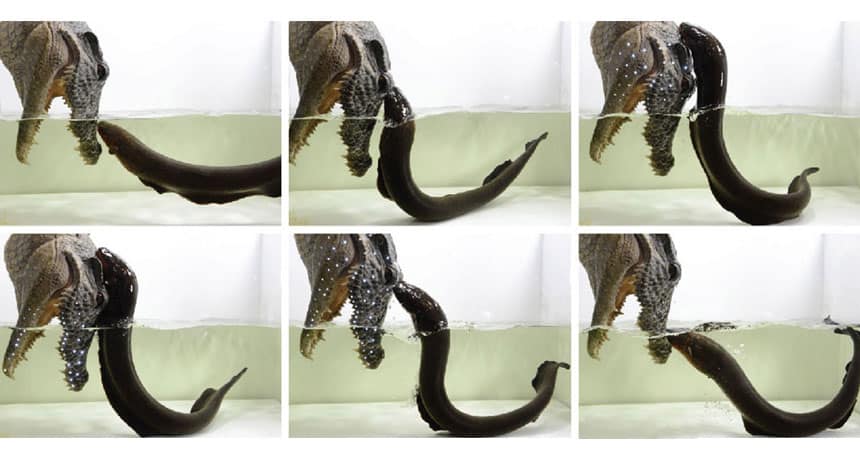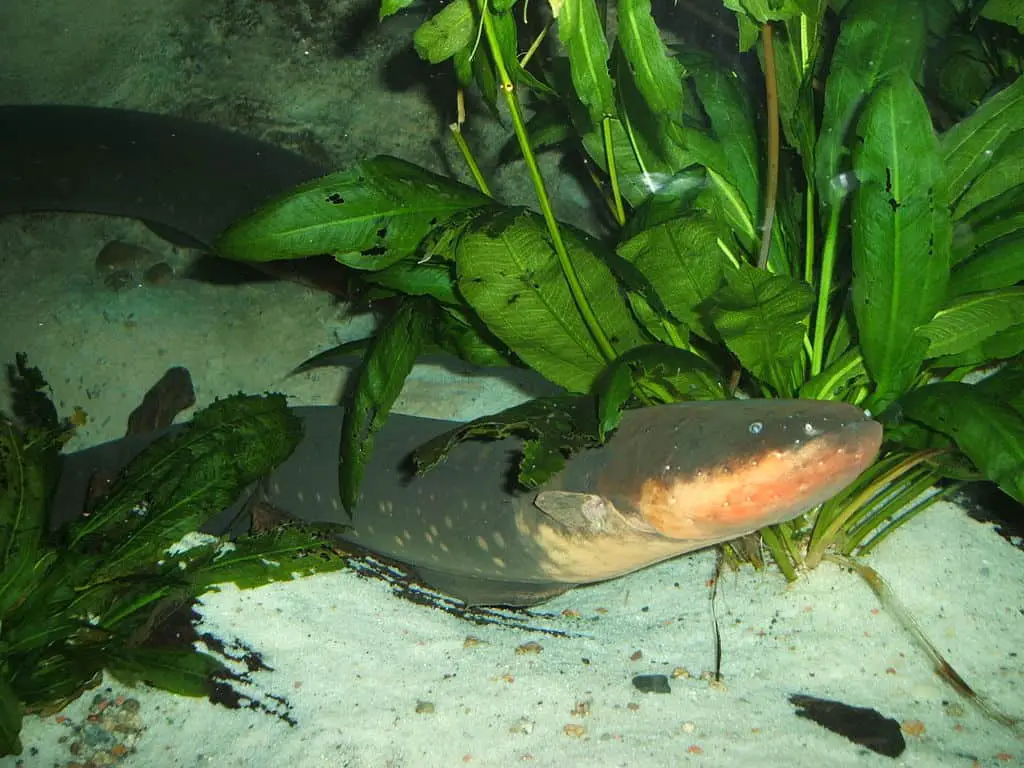Electric eels can produce 600-volt electric pulses up to 400 times per second. These high-voltage pulses are so strong that they remotely activate the neurons inside the prey, making their muscles spasm. This immobilizes the animal so the electric eel can swallow its prey whole.
Humans have been attacked and killed by electric eels, but strictly in defense and not for food.
Professor Kenneth Catania, Vanderbilt University, has discovered that the eel’s high voltage discharge doesn’t activate the prey animal’s muscles directly. Rather, the high-voltage pulses act like a remote control that hijacks the animal’s nervous system to the point that it can’t control its own muscles and they go into spasm.
Prof Catania describes the shocking action of the electric eel as a biological ‘taser,’ causing temporary neuromuscular incapacitation. Just like Tasers, the electric eel’s electrical pulses cause muscular ‘lockup’ by activating the target’s nervous system.
A full-grown electric eel can generate up to 600 to 860 volts of electricity in short, intense bursts, making it the strongest living bioelectricity generator.
Will an Electric Eel Attack a Human?
Yes, electric eels have been known to attack humans.
When attacking, electric eels rise out of the water and press their lower jaws against an arm, leg or even as high as the chest. At the same time, they generate an intense burst of high-voltage electricity. Although the amperage is low, a sustained burst could incapacitate a person to the point of drowning.
Here’s a series of photos from Prof Catania’s lab demonstrating an electric eel attacking a fake caiman head.

He has even experimented by using his own arm – see the video below:
Electric eels will attack large animals. There are numerous accounts of fishermen catching electric eels and having a caiman attack the eel for food. In each case I’ve studied, the eel shocks the caiman to the point that it either gives up or dies.
Watch what happens when this caiman, a South American crocodilian species, messes with the wrong electric eel! That’s one dead croc!
Why Do Electric Eels Attack Large Animals?
Why would this fish attack an animal larger than itself? Researchers postulate that the electric eel is protecting its territory and food source. These creatures have adapted to living in areas where the water table fluctuates seasonally, and the eels can often find themselves stuck in relatively small ponds, mudholes, and oxbows as the water recedes. They have adapted to these conditions by breathing air.
Given that they depend on the fish available in such a pond for food, eels will want to dissuade any large animal, particularly another predator, from getting established in their territory.
In 1800, the explorer Alexander von Humboldt was intrigued by the electric eel. When he arrived at a village in the Amazon rainforest the locals told him they could catch eels by “fishing with horses.”
They drove a herd of thirty horses into a shallow pond filled with electric eels and commotion ensued. The screaming, stamping horses were attacked by eels leaping out of the water to defend themselves. Two horses sank into the water and died before the eels ran out of electrical charge. Only then did the local villagers enter the water to capture some eels.
Over the next two hundred years, most people thought that the story was so unusual that Humboldt must have made it up. But research by Prof Catania has shown that Humboldt’s account matches his lab experiments with attacking eels.
Look carefully at the following illustration by Robert Schomburgk, based on Humboldt’s account. It clearly shows the eels rising up out of the water to electrocute the horses.

Why would the eel leap out of the water to shock a large intruder such as a horse or human?
You can visualize an eel as a large battery, with a positive pole at the mouth end and a negative pole at the tail end. Electricity flows from the positive to the negative pole. When an eel is totally submerged the current is conducted by the water, closing the loop.
The eel can make the shock more intense by leaping out of the water and making the electricity travel through the body of the attacker to reach the negative pole. The eel presses its chin – the positive pole – against the body of the attacker, and rises up as high as it can reach so the electricity travels down through the attacker’s body.
Watch Prof Catania explain how the eel’s leaping action increases the intensity its attack.
Can an Electric Eel Kill You?
Electric eels have killed people in South America, most likely through drowning after being shocked. There aren’t many well-documented cases of death by eel, but an electric eel’s discharge is strong enough to make a person jump in pain and to drop incapacitated into the water. Although the amperage is considered too low to cause permanent damage to humans a sustained burst of intense high-voltage could potentially cause cardiac or respiratory failure. At 600 – 800 volts, the discharge is in the same range as many defibrillators.
A sustained burst of high voltage pulses could easily incapacitate you long enough to drown.
You would be foolish to enter the water anywhere electric eels are known to inhabit the ponds or rivers.
Where Do Electric Eels Live?
Electric eels are widely distributed across northern South America. The range spans across Brazil, the Guianas, Suriname, Venezuela, Colombia, Ecuador, and Peru. It lives mainly in the murky pools and calm stretches of the middle and lower Amazon and Orinoco river basins. Recent research is showing that a newly discovered species, E voltai, lives in the faster-flowing waters of the Brazilian highlands.
Despite the name, the electric eel is not an eel, but rather a knifefish, most closely related to catfish and carp. Electric eels can grow up to 8 feet long (2.5 meters) and weigh as much as 44 pounds (20 kilograms).
Here’s a video showing the typical habitat of an electric eel in the Amazon. Watch what happens when this scientist finds an eel in the muddy water.
Why Do Electric Eels Breath Air?
Although these fish live in the water, they have become adapted to breathing air, and come to the surface frequently.
You can imagine that as small ponds and streams dry up, the water becomes muddy and murky. To adapt to such changing conditions, the eels have become obligate air-breathers, meaning that the eels must surface for air periodically.
The mouth of an electric eel has many folds to increase the surface area and a mucous membrane to absorb oxygen from the air. These special adaptations meet the respiration needs of the fish and it can breath air, rather than having to rely on gills in the warm, oxygen poor, and often muddy, waters.
How do Electric Eels Find Their Prey?
Not only can electric eels shock their prey directly, but they have also refined their electrical system to the point that they can use the signals to navigate and communicate.
They can even get their prey to reveal themselves no matter how well hidden!
Electric eels emit a steady stream of weak electric pulses to create a field around themselves. Using electroreceptors and motion sensors in the skin, the eels constantly monitor this field and immediately sense any changes in the surroundings or any motion caused by another fish.
Electroreception is a pretty amazing sensory ability, shared with some other unique creatures! Find out more How Many Senses Do Sharks Possess? (Electroreception Made Easy!) and What is a Platypus? (With Venom, Eggs, Duck-like Bills, and Electrical Receptors).
Once an eel senses a fish in the murky water, it can use a two-phased attack to capture the prey.
First, it emits two or three strong pulses, as much as 600 volts. These high-voltage pulses act like a remote control that hijacks the animal’s nervous system, stimulating the prey’s muscles. The spasming muscles twitch and generate waves that reveal the animal’s hiding place.
That’s right, if an eel is uncertain if an object is alive and worth attacking, it can make it twitch to see if its suitable for a meal!
Imagine trying to hide from a predator (or your very own bedroom monster) when the creature has the ability to make you twitch involuntarily until you reveal your hiding spot. This is the stuff of childhood nightmares!
Using its sensitive water movement detectors (the neuromasts), the eel can home in on the exact location of the twitching prey.
Once the target is within range, the eel lets loose with a volley of fast, high-voltage discharges that cause even more intense muscle contractions, incapacitating the prey. This is akin to a a biological ‘taser,’ causing muscular ‘lockup.’
This attack happens quickly; eels are able to temporarily freeze all fish body movements in only 3 milliseconds – or three one-thousandths of a second!
By curling up, the electric eel can make the discharges even more intense by overlapping the electric fields generated at each end of the electric organ.
Once the prey is immobilized the electric eel can swallow its meal whole.
According to Prof Catania, the entire attack sequence takes place in less than a second while the eel continues its high voltage volley. First, the paralyzing high-voltage pulses. Second, a fast strike towards the prey. And third, it sucks the prey into its jaws.
Watch Prof Catania explain the attack sequence using a live eel and some illustrative graphics.
What do Electric Eels Feed On?
Electric eels feed mainly on fish, but they will gladly take on amphibians and even birds and small mammals. They have small teeth and prefer to go after prey that they can swallow whole.
As we have seen, they will attack larger animals in defense when necessary, but not for food.
How do Electric Eels Produce Electricity?
Electric eels have thousands of muscle cells, each creating tiny amounts of electric current. When combined, 6,000 muscle cells working together can generate up to 600 volts. Compare this to the 120 volts of a household wall socket in North America.
Three specialized electric organs make up about 80 percent of electric eel’s body. These are the main electrical organ, the Hunter’s organ, and the Sachs’ organ. Vital organs like the heart and liver, are all tightly packed at the front part of the eel’s body.
Each electric organ is filled with stacks of thousands of disc-shaped cells called electrocytes. Normally, electrocytes pump out sodium and potassium ions to maintain a negative charge inside the cell and a positive charge on the outside. The fish’s brain sends a signal through its nervous system to the electrocyte to open the ion gates. Positively charged ions flow back into the electrocyte.
The electrocytes are arranged so there are two sides with opposite charge patterns. These alternating charges can drive a current, turning the electrocyte into a biological battery.
The eel can make a high-voltage discharge by coordinating the nerve signals so they arrive at each cell at exactly the same time. When this happens the stacks of electrocytes act like thousands of batteries in series. The tiny charge from each electrocyte adds up to form a high voltage electrical shock that can travel several meters.
Watch this informative video to learn how fish make electricity.
Have you ever received an accidental shock from your 120-volt household current? Even a momentary encounter with a shorting lamp or electric tool makes for a memorable experience. Once you’ve experienced 120-volts, imagine what 600 volts would feel like! Its not too difficult to imagine that such an intense shock could lead to serious damage or death.
Three Species of Electric Eel: Including the Strongest Living Bioelectricity Generator

DNA analysis by de Santana et al (2019) has revealed that there are actually three species of electric eel: the previously known Electrophorus electricus, along with E. voltai and E. varii.
One of these newly discovered species E. voltai qualifies as the strongest living bioelectricity generator known to science. This remarkable fish can deliver a jolt of 860 volts – a big jump from the 650 volts previously recorded from electric eels.
Each of the three species has a clearly defined range. E. electricus lives in the Guiana Shield region, E. voltai in the Brazilian Shield, a highland further south, and E. varii inhabits the slow-flowing waters of the Amazon basin.
How do Electric Eels Communicate?
Electric eels communicate by using weak discharges from their electric organs.
Eels can vary the duration of each electric pulse and the time lapse between pulses. Differences between the pulses allow eels to distinguish between males and females, and each individual has a recognizable signature pattern of its own.
By varying the frequency of electric pulses, eels can communicate with other eels about their sex and sexual receptivity, especially during the breeding season.
Using their impressive array of biosensors, electric eels can easily detect these electric signals and can readily decipher vital information about each of the other eels sharing the same pond or stretch of water.
I have some great articles on the fascinating science of animal communication. Check these out:
Whales don’t have vocal chords – but they are master communicators. How Do Whales Communicate and Make Sounds Under Water? Latest Science
Crocs might be smarter than you think! How Smart are Crocodiles? Can They Cooperate, Communicate…Use Tools?
How do octopuses communicate? Octopus Communication Unveiled: Unlocking Their Secret Language
Fun Facts About Electric Eels
- In South America electric eels are known as poraquê – the one who puts you to sleep! Locals use the oil to treat rheumatism, osteoporosis, and insect and snake bites.
- Early attempts to understand electricity made use of electric eels. Michael Faraday, the famous electrical pioneer, had an electric eel shipped over from Guyana for his electrical experiments.
- The electric eel inspired the design of the first electric battery.
- Electric eels have been used to provide some festive cheer and to get people all charged up for Christmas!
References
de Santana, C.D., Crampton, W.G.R., Dillman, C.B. et al. 2019. Unexpected species diversity in electric eels with a description of the strongest living bioelectricity generator. Nat Communication 10, 4000 (2019). https://doi.org/10.1038/s41467-019-11690-z
Catania, K.C., 2015. Electric eels concentrate their electric field to induce involuntary fatigue in struggling prey. Current Biology, 25(22), pp.2889-2898.
Catania, Kenneth, 2020. Great Adaptations: Star-nosed Moles, Electric Eels & Other Tales of Evolution’s Mysteries Solved. Chapter 6: You Had Me at 500 Volts.
Header photo of electric eel by Scott on Flickr Creative Commons SA-by-2.0
See Our TOP Articles for More Fascinating Creatures
- How do Octopus Reproduce? (Cannibalistic Sex, Detachable Penis)
- How Smart are Octopuses? Are Octopuses As Intelligent as Dogs?
- Do Jellyfish have Brains? How Can they Hunt without Brains?
- Why are Deep Sea Fish So Weird and Ugly? Warning: Scary Pictures!
- Are Komodo Dragons Dangerous? Where Can you See Them?
- Koala Brains – Why Being Dumb Can Be Smart (Natural Selection)
- Why do Lions Have Manes? (Do Dark Manes Mean More Sex?)
- How Do Lions Communicate? (Why Do Lions Roar?)
- How Dangerous are Stonefish? Can You Die if You Step on One?
- What Do Animals Do When They Hibernate? How do they Survive?
- Leaf Cutter Ants – Surprising Facts and Adaptations; Pictures and Videos
- Irukandji Jellyfish Facts and Adaptations; Can They Kill You? Are they spreading?
- How to See MORE Wildlife in the Amazon: 10 Practical Tips
- Is it Safe to go on Safari with Africa’s Top Predators and Most Dangerous Animals?
- What to Do if You Encounter a Bullet Ant? World’s Most Painful Stinging Insect!
- How Do Anglerfish Mate? Endless Sex or Die Trying!
- How Smart are Crocodiles? Can They Cooperate, Communicate…Use Tools?
- How Can We Save Our Oceans? With Marine Sanctuaries!
- Why Are Male Birds More Colorful? Ins and Outs of Sexual Selection Made Easy!
- Why is the Cassowary the Most Dangerous Bird in the World? 10 Facts
- How Do African Elephants Create Their Own Habitat?
- What is Killing Our Resident Orcas? Endangered Killer Whales
- Why are Animals of the Galapagos Islands Unique?
- Where Can You See Wild Lemurs in Madagascar? One of the Best Places
- Where Can You see Lyrebirds in the Wild? the Blue Mountains, Australia
- Keeping Mason Bees as Pets
- Why do Flamingos have Bent Beaks and Feed Upside Down?
- Why are Hippos Dangerous? (Do They Attack People?)

